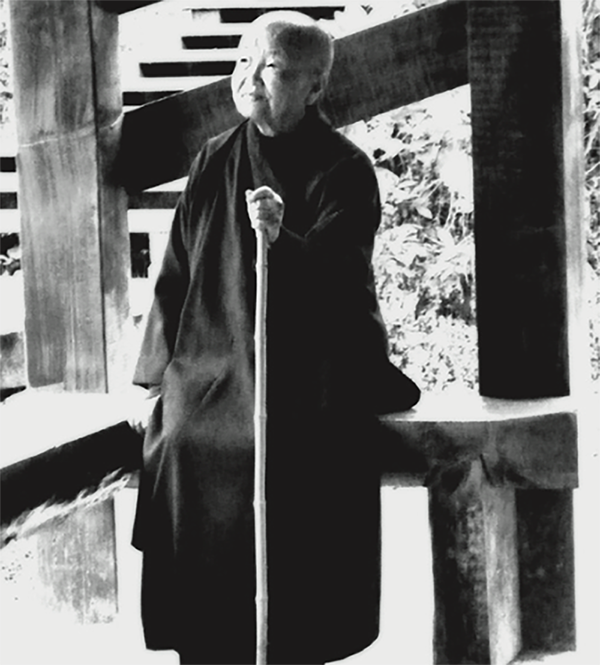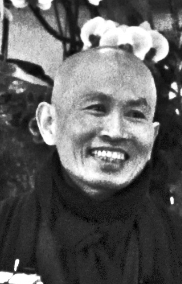The Spirit of the Fourteen Mindfulness Trainings
By the Venerable Thich Phuoc Tinh

Dear community, today is the last day of the Vietnamese retreat. There was a Fourteen Mindfulness Trainings transmission ceremony yesterday. Most of the people here are practitioners who have already received the Fourteen Mindfulness Trainings. Regrettably, there was no time for Sister Chan Khong and Brother Phap Dang to share the meanings of the Fourteen Precepts.
The Spirit of the Fourteen Mindfulness Trainings
By the Venerable Thich Phuoc Tinh

Dear community, today is the last day of the Vietnamese retreat. There was a Fourteen Mindfulness Trainings transmission ceremony yesterday. Most of the people here are practitioners who have already received the Fourteen Mindfulness Trainings. Regrettably, there was no time for Sister Chan Khong and Brother Phap Dang to share the meanings of the Fourteen Precepts. I only heard Sister Chan Khong talk about a couple of things, due to time constraints. Thus, I would like to contribute a few ideas. I think that there will be an opportunity for you to inquire of Sister Chan Khong to be more informed about the scope of the history of the Order of Interbeing.
In reality, things are not as simple as we may perceive. For the majority of practitioners who have just gotten to know Thay, they think that to receive the Fourteen Mindfulness Trainings and wear the Order of Interbeing jacket is a simple matter. They do not know that the Order of Interbeing began in the 1960s. Presently, it seems that only a few of the elders—those who are long-standing OI veterans—remain with us. One of the people remaining, whom we need to treasure, is Sister Chan Khong. Once I heard Thay mention that during a retreat in Europe, nobody had brought the text of the Fourteen Precepts. Therefore, Sister Chan Khong had to retype it. And from where did she retype it? It flowed out from her own heart. She had learned the text by heart very accurately, as if it had been meticulously stored in the museum of consciousness.
The text of the Fourteen Precepts is not a text to be recited every two weeks. It is a text that we must learn by heart. Every single word is an attainment that has been conscientiously selected and that flows eloquently from the insights of a spiritual teacher who is deeply imbued with both the Pali canon and the Chinese Buddhist canon. In the Kalama Sutta from the Anguttara Nikaya, the Buddha said: “Do not believe the words just because they come from the teacher that you respect. Do not believe the words just because they come from spiritual literature that has been there for thousands of years. Do not believe the words just because they are transmitted down from tradition.” There are ten phrases with similar content in that sutra.
As we read in the First Mindfulness Training, Thay says that we need to be aware of fanaticism due to intolerance for doctrines, which has caused suffering in mankind. Therefore, for OI members, the First Precept tells us not to be bound to any ideology, even if it is a Buddhist ideology. This proves that the OI text is crystallized from the insights of a great spiritual teacher who has integrated and merged the substratum of both the Agama scriptures (e.g., Nikaya Sutra) and the Mahayana scriptures in order to create the Fourteen Precepts. OI practitioners and Buddhists who have received the Five Mindfulness Trainings should learn the text by heart because each word embodies Thay’s selfless vow to apply wisdom and compassion to bring the Buddha’s teachings into everyday life, and serves as a fundamental principle for our practice.
Secondly, we should have some knowledge about the history of the Order of Interbeing. In the harrowing and agonizing years of the Vietnam War, the School of Youth for Social Service was born as a heartwarming home, nurturing the youth with altruistic ideals. To be a worker for this school, young people followed Thay to receive the OI precepts, bringing their fiery, fearless, loving hearts to a war-torn nation and hoping to relieve the suffering and pain of the people. They tried to heal the wounds created by the anguish and horror of the Vietnam War. The first OI generation sacrificed greatly because both sides of the war hardly had sympathy for Thay’s revolutionary concept of Engaged Buddhism. These people fell down due to the hatred, the cruelty, the insanity of mankind. Nhat Chi Mai immolated herself in the name of peace; Phuong Lien and Vui were hit by grenades at Phap Van temple while helping people in need. On the path of the Order of Interbeing, blood from the early generation spilled on the ground to form a foundation for us to walk on and continue the work of the bodhisattvas. For the Order of Interbeing to be sustained until the present time, it had to withstand the intensely violent period of the Vietnam War and the loathing and envy of many people.
Tracing far back to its origin, we can see that the Order of Interbeing was germinated very early. Its silhouette could be seen in books like The Novice and was reflected boldly in Thay’s books about Engaged Buddhism during the 1960s. It gave shape to a Vietnamese Buddhism embodying a steadfast, unwavering, vibrant vitality, plus a profound energy to survive and to be of benefit to the life of mankind in the present and in the future.
The words Tiep Hien have a multi-faceted connotation. The Order of Interbeing is not just a regular organization. I would like to offer a few explanations so we can see that these two words contain very profound insights. At the ordinary level, the role of OI members carries the form of a connection between monastics, laypeople, and people from all backgrounds. They have the responsibility of bringing the Dharma into real life, in other words, applying Buddhism in everyday life to relieve suffering and to beautify the world. However, this is only a very shallow meaning of the phrase.
The second definition of these words is to acquire and continue the bodhisattva vows from the past, manifesting the virtues of wisdom and compassion in this world. At the third level, a much more in-depth connotation is to fully realize the Buddha nature within ourselves, meaning to be able to live with the energy of no-birth, no-death, or to live with the energy of true awareness already inherent in us. Then we will dwell peacefully in this true presence to properly conduct ourselves in life, turning the Dharma wheels to contribute the fundamental truth of the ultimate reality to this world.
Thus, the true connotation of Tiep Hien is very profound. It is to realize and sustain the Buddha nature already existing in everyone. Expressed in a different way, we have always carried within ourselves the enlightened essence, the awakened bodhi nature. And from this formless presence, we have the power to manifest it into differentiated forms for the well-being of the world. We have the power to manifest it on our spiritual path of Engaged Buddhism in order to help others with the same capabilities to attain enlightenment like us. Now, that is the true connotation of Tiep Hien.
Naturally, an OI member’s task is to acquire and continue the vows of bodhisattvas like Avalokiteshvara, Manjushri, Samanta-bhadra, and Mahasthamaprapta, to engage in compassionate service for others. And the most imperative undertaking is to realize the true essence, the awakened nature inherent right within ourselves, to complete the spiritual path for ourselves and for others.
In the tradition of Buddhist novice monks from China to Vietnam, there was a type of precept that they received besides the novice precepts and the great precepts of the fully ordained monks and nuns. The Fourteen Mindfulness Trainings can be compared to the bodhisattva precepts of the tradition in Vietnam. I want to share with you the traditional bodhisattva precepts. They can be condensed into four great vows:
Beings are numberless; I vow to save them.
Afflictions are boundless; I vow to end them.
Dharma gates are immeasurable; I vow to learn them.
The path of awakening is unsurpassable; I vow to attain it.
You can condense this into two words. What are they? Wisdom and compassion. In every retreat that Thay held, we began by chanting Avalokiteshvara and ended with the Heart Sutra. Even just in the ceremony, we transmitted that spirit of love and understanding, or wisdom and compassion. All the practices, the great vows, come down to cultivating understanding and love. If you read the trainings that Thay has offered, they all embody these two words, understanding and love.
There is the practice of the Six Paramitas in Buddhism. One of the paramitas is practicing generosity. This morning, a lay friend asked me, “Does practicing the Six Paramitas lead to nirvana?” I answered, “The foundation of the other five paramitas is wisdom. Generosity without insights will only give merits to reincarnate as heavenly beings. However, with wisdom, these merits will build a solid substructure to attain Buddhahood.”
The first vow says that there are countless beings and you vow to save them. The bodhisattva of great aspiration, Kshitigarbha, has that great vow. He vows that until he helps all people in darkness, in the realms of hell, he will not be willing to go to enlightenment. If there is one being left, he still doesn’t want to become enlightened. Dear friends, there is no Buddha that does not keep this vow.
I hope one day you have time to consult with Sister Chan Khong about the spirit of the Fourteen Mindfulness Trainings. I hope the elder brothers and sisters in the Order of Interbeing will record the history and the meaning of the Fourteen Mindfulness Trainings. For a younger generation like us, maybe one day we won’t have all the facts and the meaning of the trainings. If you don’t cherish Sister Chan Khong’s presence and help her to do this kind of work, then in ten or twenty years, we will not have people to do this work.
This article is an excerpt of a Dharma talk given on November 8, 2015, at Deer Park Monastery. The talk was translated by Monglan Ho and Brother Phap Khai. The excerpt was edited by Natascha Bruckner and Sister Annabel, True Virtue.

The Venerable Thich Phuoc Tinh was born in 1947 in Vietnam. He received full ordination in 1980 and became abbot at the Temple of the Bodhisattva of Compassion (Quan The Am) in Da Lat in 1993. In 2001, he was invited by Thich Nhat Hanh to live at Deer Park Monastery, where he continues to reside. Collections of his talks in English are presented in Be Like A Tree: Zen Talks by Thich Phuoc Tinh and The Ten Oxherding Paintings: Zen Talk by Thich Phuoc Tinh. He is also the author of three books in Vietnamese, one on the Forty-Two Chapters Sutra and two of Dharma talks sharing wisdom for everyday life.

